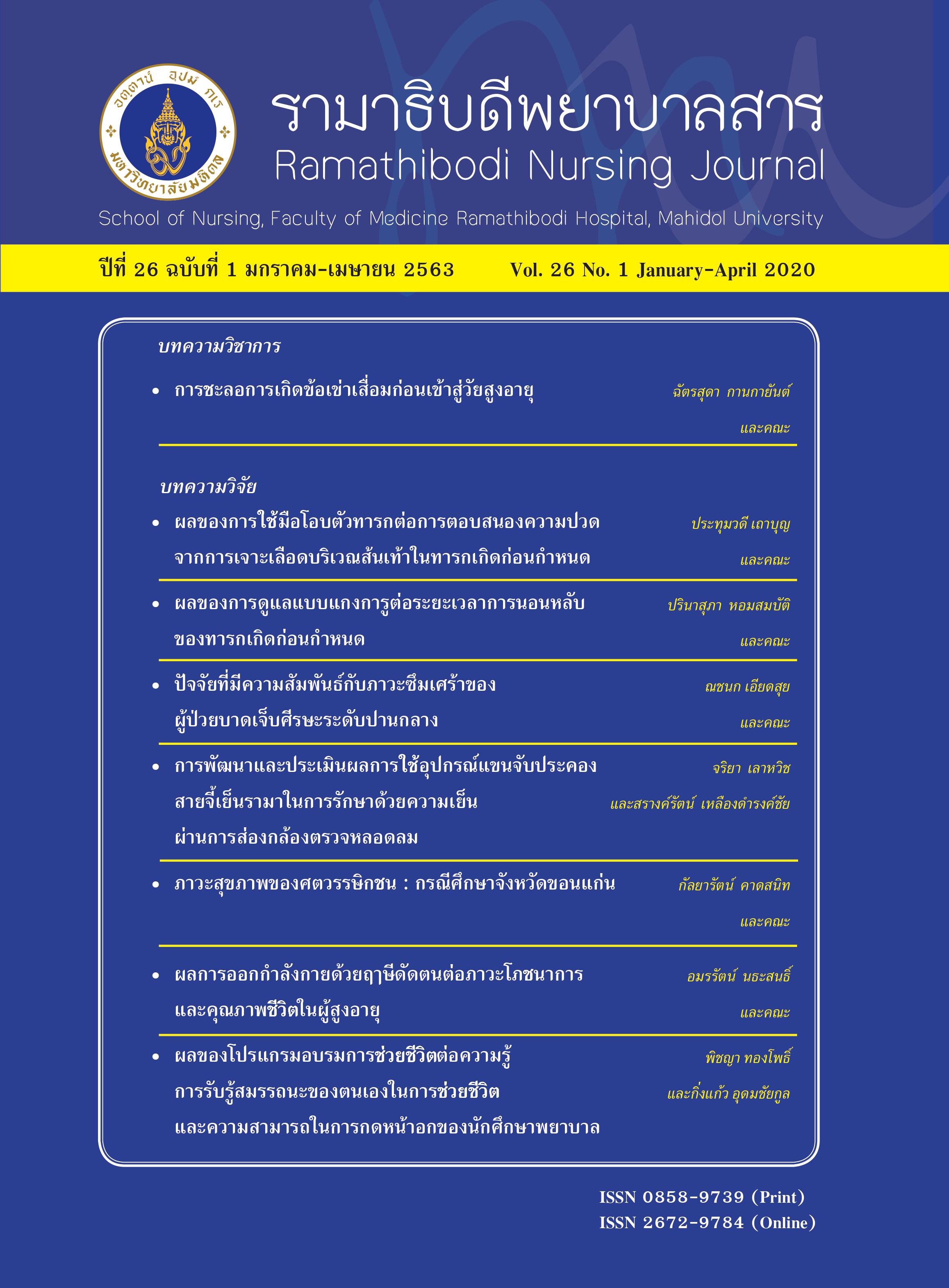The Effect of Kangaroo Care on Sleep Duration in Preterm Infants
Main Article Content
Abstract
This study aimed to compare the average sleep duration of preterm infants between Kangaroo care and usual care. A quasi-experimental study with a crossover design was used. The samples consisted of 20 pairs of mothers and preterm infants recruited using purposive sampling from one university hospital, Pathum Thani Province, during May–September 2018. Each pair of samples was randomly assigned to either the experiment or the control situation first and vice versa. The Kangaroo care is a method of holding a baby that involves skin-to-skin contact. The sleep-wake state was evaluated using the tape record and evaluation guidelines. The data were analyzed using paired t-test or Wilcoxon Signed-rank test. The findings showed that the preterm infants during Kangaroo care had the average sleep time longer than during usual care with a statistical significance. The results of this study support the study hypothesis and assure the WHO
recommendation to provide Kangaroo care for at least one hour and keep continuing as long as possible for the optimum benefit of Kangaroo care.
Article Details
บทความ ข้อมูล เนื้อหา รูปภาพ ฯลฯ ที่ได้รับการตีพิมพ์ในรามาธิบดีพยาบาลสาร ถือเป็นลิขสิทธิ์ของวารสาร หากบุคคลหรือหน่วยงานใดต้องการนำทั้งหมดหรือส่วนหนึ่งส่วนใดไปเผยแพร่หรือเพื่อกระทำการใด ใด จะต้องได้รับอนุญาตเป็นลายลักษณ์อักษรจากรามาธิบดีพยาบาลสารก่อนเท่านั้น
References
Bureau of Policy and Strategy, Ministry of Public Health.Vital statistics-birth database; 2012. [cited 2015 April
. Available from: https://bps.ops.moph.go.th/Healthinformation/statistic55/2.1.5_55.pdf (in Thai)
World Health Organization. WHO health statistics: A critical review the incidence of low birthweight. 2015.
[cited 2015 April 20]. Available from World Health Organization website: https:// www.who.int/news-room/
fact-sheets/detail/preterm-birth
Gardner SL, Lubchenco LO. The neonate and the environment: impact on Development. In: Gardner SL,
Merenstein GB, Editors. Handbook of neonatal intensive care. St Louis: Mosby; 1998.
Blackburn ST. Environment impact of the NICU on development outcomes. J Pediatr Nurs. 1998;13(5):279-89.
Lefrak L, Lund HC. Nursing practice in the neonatal intensive care unit. In: Klaus HM, Fanaroff AA, Editors.
Care of the high-risk neonate. Philadelphia: W. B.Saunders; 2001. p.223-42.
Srisawet S, Daramas T, Pookboonmee R. Effects of Mozart’s music on heart rate, respiratory rate, oxygen
saturation, and sleep duration of preterm infants.Ramathibodi Nursing Journal. 2013;19(2):221-34. (inThai)
Uplike. Music therapy result for ICU patients. Dimens Crit Care Nurs. 1990;9(1):39-45.
World Health Organization. Kangaroo mother care-a practice guide. Department of Reproductive Health and
Research. WHO, Geneva; 2003.
Messmer PR, Rodriguez S, Adams J, Well-Gentry J,Washburn K, Zabaleta I, et al. Effect of kangaroo care on
sleep time for neonates. Pediatr Nurs. 1997;23(4):408-14.
Ludington-Hoe SM, John MW, Morgan K, Lewis T, Gutman J, Wilson PD, et al. Neurophysiologic assessment of neonatal sleep organization: preliminary result of randomized, controlled trial of skin contact with preterm infant. Peds. 2006;117(5):e909-e23.
Feldman R, Weller Al, Eidelman AI, Sirota L. Skin to skin contact (Kangaroo care) promotes Self-regulation in
premature infant: sleep wake cyclicity, arousal modulation,and sustained exploration. Dev psychol. 2002;38:194-207.
Bastani F, Rajai N, Farsi Z, Als H. The effect of kangaroo care on sleep and wake states of preterm infants. J Nurs Res. 2017;25(3):231-39..
Ludington-Hoe SM. Evidence-based review of physiologic effect of kangaroo care. Curr Wom Health Rev. 2011;7 (3):1-11.
Dodd VL. Implications of kangaroo care for growth and development in preterm infants. JOGNN. 2005;34
(2):218-32.
McCain GC, Ludington-Hoe SM, JY, Hadeed AJ. Heart rate variability responses of a preterm infant to kangaroo care. J Obstet Gynecol Neonatal Nurs. 2005;34(6):689-94.
Johnston CC, Stevens B, Pinelli J, Gibbins S, Fillion F,Jack A, et al. Kangaroo care is effective in diminishing
pain response in preterm neonates. Arch Pediatr Adolesc Med. 2003;157(11):1084-88.
Feldmn R, Eidelman AI. Skin to skin contact (Kangaroo care) accelerate autonomic and neurobehavioral maturation in preterm infants. Dev Med Child Neurol. 2003;45:274-8.
Als H. Toward a synactive theory of development: Promise for the assessment and Support of Infant individuality. Inf Mental Health J. 1982;3(4):229-43.
Parmalee AH, Stern E. Development state in infants. In:Clemente C, Purpura DP, Mayer FE, Editors. Sleep and
maturing nervous system. London: Academic Press; 1972.p.199-214.
Charastong C. A study of sleep pattern in premature infants.Unpublished master thesis, Master of Nursing Science (Maternal and Child Nursing), Faculty of Graduate Studies, Mahidol University; 2001.
Salk L. The role of heartbeat in the relations between mother and infant. Sci Am. 1973;228 (5):24-9.


